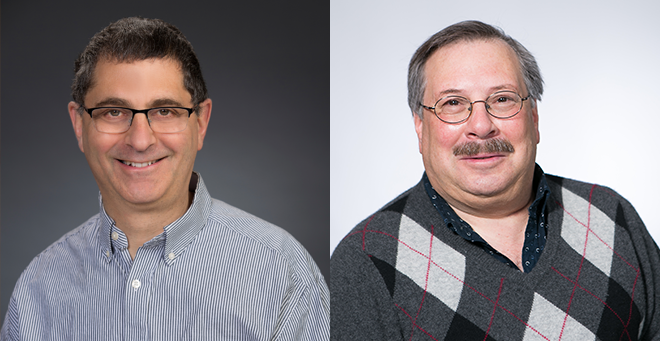A potential therapeutic against hookworms is being developed by scientists from UMass Medical School, Cummings School of Veterinary Medicine at Tufts University, the USDA Agricultural Research Service and the Synthetic Biomanufacturing Facility at Utah State University. Described in a study published in Antimicrobial Agents and Chemotherapy, the therapeutic is an engineered bacterium, containing crystal compound 5B inactivated with a food-grade oil that can be used to safely treat hookworms in animal models. It can be easily delivered to patients and manufactured in large volumes for mass distribution.

“This study lays the foundation for completing preclinical studies as a prelude to clinical studies and introduction of a new hookworm therapy,” said Raffi Van Aroian, PhD, professor of molecular medicine. “Our work meets all of the difficult challenges associated with developing new hookworm therapies that can alleviate suffering and poverty throughout much of the world.”
Human hookworms are one of the most debilitating parasitic diseases of children and adults worldwide. These parasites burrow into the small intestine and feed on blood, causing anemia. In children, these parasites result in significant growth stunting, underperformance in school and reduced economic earnings later in life. They can be life threatening to pregnant women. They cause lethargy and reduced productivity in working adults. At least half a billion people in the poorest countries in the world are infected.
Only one class of drugs, benzimidazoles, is routinely used for mass-scale treatment of hookworms. Resistance to this class of drugs, which was initially developed to treat livestock, is well known and low efficacy of the drug is already seen in many parts of the world.
“The difficulty in developing new therapeutics for this important disease is that the people infected are some of the poorest in the world, the scale is massive and there is no cold chain for storage of pharmaceuticals,” said Dr. Aroian. “Any new cures need to be cheap, scalable and room-temperature stable. Because of these compounding factors, there have been no new cures introduced for more than 30 years and there are few, if any, new cures in the commercial pipeline.”
Aroian and colleagues turned to Bacillus thuringiensis, or Bt, for a solution. A species of bacteria that lives in soil, Bt is commonly used as an insecticide in organic farming. It produces crystal proteins that are toxic to some insects when eaten, but not others. Different strains of Bt produce unique protein structures that are toxic to different pests, creating a vast reservoir of targeted natural insecticides. The proteins are not toxic to humans because, like all mammals, they cannot activate them or bind them.
Aroian found that the Bt crystal protein 5B can kill gastrointestinal nematodes, of which hookworms are the most important in humans.
Bt crystal proteins are delicate and delivering them intact through the stomach to humans and other mammals is a formidable challenge. Gary R. Ostroff, PhD, professor of molecular medicine, identified a food-grade essential oil that kills the bacteria that makes Cry5B but leaves the crystal protein intact. The bacterium was specifically engineered to make this possible.
Probiotics are live microorganisms that, when ingested in adequate amounts, can provide health benefits to the host. These benefits are provided as a result of interactions between the probiotics and the gastrointestinal microbiota and host’s immune system.
“For safety reasons, it is not desirable to administer large quantities of live Bt to animals,” said Dr. Ostroff. “This meant that delivery as a probiotic wasn’t an option. We had to design a way to deliver the crystal protein another way. That way turns out to be through a paraprobiotic.”
Nonviable probiotics have been known as “ghost probiotics,” “postbiotics” and “inactivated probiotics,” but recently the term paraprobiotics has been used.
Using food-grade oils, Aroian and Ostroff developed a process to produce a paraprobiotic product called Cry5B IBaCC (inactivated bacteria with cytosolic crystals) that was able to cure human hookworm infections in laboratory animal models in a single dose. Moreover, Cry5B IBaCC could be dried down into a room-temperature stable powder and its production was successfully scaled up to 350 liters at a biomanufacturing facility at Utah State University.
Repeated dosing of the Cry5B IBaCC treatment at five times the curative amount showed no signs of toxicity in animal models, demonstrating that the product is safe at very high and repeated doses.
“The obstacles to introducing a new antiparasitic drug to the market are almost insurmountable,” said Aroian. “In 30 years, there have been no new drugs developed for humans. We have finally broken through that logjam. Our Cry5B IBaCC product is produced by a scalable, simple process that can be made inexpensively anywhere in the world.”
Ostroff added, “Cry5B IBaCC is a new paradigm for treating parasitic worms while dealing with impending drug resistance. This can be part of a formidable arsenal to alleviate a huge unmet health need in the world.”
The next step for Aroian and Ostroff is to raise funding for preclinical toxicity studies prior to moving to clinical studies in humans.
Related links on UMassMed News
UMass Medical School to participate in World Neglected Tropical Diseases Day on Jan. 30
Hookworm infection may cause cognitive impairment earlier than thought
Worcester Tech students credit UMMS support as key to biotech career path